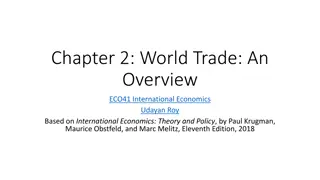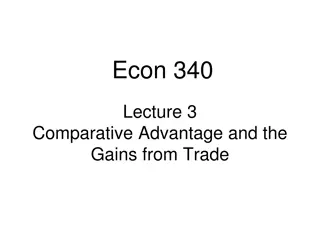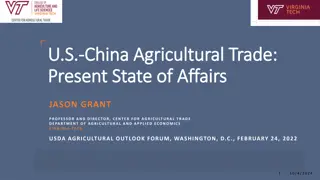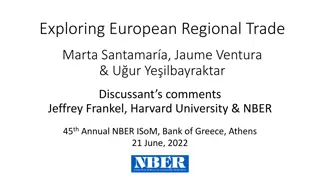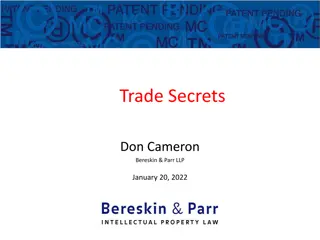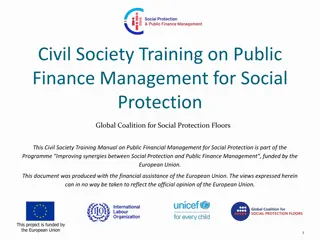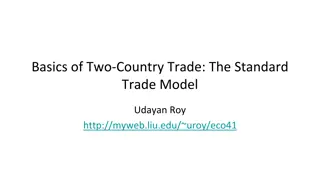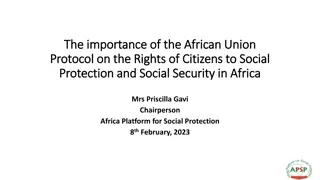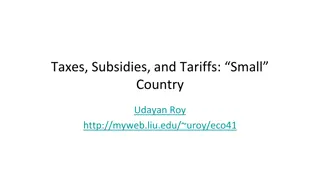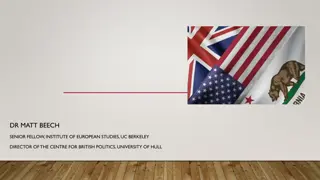The Evolution of Social Protection and Free Trade
Social protection and free trade have been intertwined throughout history, with battles over autarchy and market economies. Economic liberalism faced defeats in the past due to illusions and challenges in adapting to changing economic landscapes. The concept of autarchy has been prophetically significant, pointing to the need for adjustments in a shifting global order.
Download Presentation

Please find below an Image/Link to download the presentation.
The content on the website is provided AS IS for your information and personal use only. It may not be sold, licensed, or shared on other websites without obtaining consent from the author. Download presentation by click this link. If you encounter any issues during the download, it is possible that the publisher has removed the file from their server.
E N D
Presentation Transcript
Social protection implies in autarchy??? Free trade which, in 1846, had been fought and won on the Corn Laws, was eighty years later fought over again and this time lost on the same issue. The problem of autarchy haunted market economy from the start. Accordingly, economic liberals exorcised the spectre of war and naively based their case on the assumption of an indestructible market economy. It went unnoticed that their arguments merely showed how great was the peril of a people which relied for its safety on an institution as frail as the self-regulating market. The autarchy movement of the 1920s was essentially prophetic: it pointed to the need for adjustment to the fact of a vanishing order (Polanyi [1944] 2001, pp. 198-199).
For this class In the 1940s economic liberalism suffered an even worse defeat. Although Great Britain and the United States departed from monetary orthodoxy, they retained the principles and methods of liberalism in industry and commerce, the general organization of their economic life. This was to prove a factor in precipitating the war and a handicap in fighting it, since economic liberalism had created and fostered the illusion that dictatorships were bound for economic catastrophe. By virtue of this creed, democratic governments were the last to understand the implications of managed currencies and directed trade ; also, the legacy of economic liberalism barred the way to timely rearmament in the name of balanced budgets and stable exchanges, which were supposed to provide the only secure foundations of economic strength in war (Polanyi [1944] 2001, p. 149).
The Politics of Economic Nationalism Class 4 Re-Embedding Markets Dr. Vin cius Rodrigues Vieira (IRI-USP) August 22, 2018
The Double Movement For a century, the dynamics of modern society was governed by a double movement: the market expanded continuously but this movement was met by a countermovement checking the expansion in definite directions. Vital though such a countermovement was for the protection of society, in the last analysis it was incompatible with the self-regulation of the market, and thus with the market system itself (Polanyi [1944] 2001, p. 136).
A long-term trend towards autarchy... since the 1870s an emotional change was noticeable though there was no corresponding break in the dominant ideas. The world continued to believe in internationalism and interdependence, while acting on the impulses of nationalism and self-sufficiency. Liberal nationalism was developing into national liberalism, with its marked leanings towards protectionism and imperialism abroad, monopolistic conservatism at home. Nowhere was the contradiction as sharp and yet as little conscious as in the monetary realm. For dogmatic belief in the international gold standard continued to enlist men's stintless loyalties, while at the same time token currencies were established, based on the sovereignty of the various central banking systems. Under the aegis of international principles, impregnable bastions of a new nationalism were being unconsciously erected in the shape of the central banks of issue (Polanyi [1944] 2001, p. 207).
That is, more and more.... Factors of production became a matter of national sovereignty Labor with growing social rights Trade with rising tariffs Capital/money with central banks (amid the gold standard) What has Polanyi missed???
That is, more and more.... Factors of production became a matter of national sovereignty Labor with growing social rights Trade with rising tariffs Capital/money with central banks (amid the gold standard) What has Polanyi missed??? Immigration/minorities who is a citizen de facto? This explains...
Economic Nationalism (i.e., protectionism)
Economic Nationalism (i.e., protectionism) National Identity (i.e., who belongs) THE POLITICS OF ECONOMIC NATIONALISM
However, lets first study the 1920s in depth Banking rises after World War I just to collapse again There is indeed nothing surprising either in the dominating influence of international bankers in the 1920s, nor in their eclipse in the 1930s. In the 1920s, the gold standard was still regarded as the precondition of a return to stability and prosperity, and consequently no demand raised by its professional guardians, the bankers, was deemed too burdensome, if only it promised to secure stable exchange rates; when, after 1929, this proved impossible, the imperative need was for a stable internal currency and nobody was as little qualified to provide it as the banker (Polanyi [1944] 2001, p. 208).
However, lets first study the 1920s in depth That is the case as governments controls labor and tariffs With the international gold standard the most ambitious market scheme of all was put into effect, implying absolute independence of markets from national authorities. World trade now meant the organizing of life on the planet under a self-regulating market, comprising labor, land, and money, with the gold standard as the guardian of this gargantuan automaton. Nations and peoples were mere puppets in a show utterly beyond their control. They shielded themselves from unemployment and instability with the help of central banks and customs tariffs, supplemented by migration laws. These devices were designed to counteract the destructive effects of free trade plus fixed currencies, and to the degree in which they achieved this purpose they interfered with the play of those mechanisms. (Polanyi [1944] 2001, p. 208).
However, lets first study the 1920s in depth Therefore, banking has collapsed due to the lack of regulation In contrast to men and goods, money was free from all hampering measures and continued to develop its capacity of transacting business at any distance at any time. The more difficult it became to shift actual objects, the easier it became to transmit claims to them... Payments, debts, and claims remained unaffected by the mounting barriers erected against the exchange of goods; the rapidly growing elasticity and catholicity of the international monetary mechanism was compensating, in a way, for the ever-contracting channels of world trade. When, by the early 1930s, world trade was down to a trickle, international short-term lending attained an unheard-of degree of mobility (Polanyi [1944] 2001, p. 215).
Consequences of impaired regulation According to Polanyi ([1944] 2001, p. 218) Tension of classes unemployment Pressure on exchange rates lack of foreign currency/financial stability Imperialist rivalries countries are less eager to cooperate with each other
Great Depression: The Reaction US as a latecomer in providing comprehensive social security through the Social Security Act (SSA) in 1935: American exceptional Welfare State
Was the New Deal socialist? Socialism is, essentially, the tendency inherent in an industrial civilization to transcend the self- regulating market by consciously subordinating it to a democratic society. It is the solution natural to industrial workers who see no reason why production should not be regulated directly and why markets should be more than a useful but subordinate trait in a free society
Was the New Deal socialist? From the point of view of the community as a whole, socialism is merely the continuation of that endeavor to make society a distinctively human relationship of persons which in Western Europe was always associated with Christian traditions. From the point of view of the economic system, it is, on the contrary, a radical departure from the immediate past, insofar as it breaks with the attempt to make private money gains the general incentive to productive activities, and does not acknowledge the right of private individuals to dispose of the main instruments of production
The New Deal was not socialist This is, ultimately, why the reform of capitalist economy by socialist parties is difficult even when they are determined not to interfere with the property system (Polanyi [1944] 2001, p. 242) Post-Depression and Post-War: capital(productive)-labor alliance What is missing though???
Quick Task Imagine that you and your closest colleague are part of Roosevelt s team in assembling the New Deal measures in the 1935s. At that time, the Democratic Party to which the president belongs relied heavily on the support of whites from Southern states, which do not grant the right of voting to blacks and other racial minorities. Which concessions would you advise the president to make in order to grant the support necessary for approving social protection? Discuss in pairs in the next two minutes Clue: most manufacturing workers are White and live in Northern states (including the current Rust Belt).
The Great Migration Blacks leave the South For an alternative view on the exclusion of agricultural and domestic workers from the SSA in 1935, https://www.ssa.gov/policy/docs/ssb/v70n4/v70n4p49.html
Beyond contentions with Blacks Not all whites were equal....



